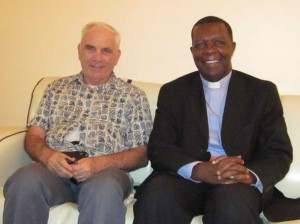On July 13, we drove around downtown Kinshasa, and I marveled at the traffic. We were not far from the city center, with its enormous soccer stadium, Hall of Justice, and the government center. We dropped Albert Shuyaka off at a school where he could get a new identity card. He had been out of the country for five years, and needed to register to vote. This fall President Joseph Kabila will again be running for President, and Albert wants to vote in the election.
We visited the Interdiocesan Center and called upon Bishop Djomo, our host and the President of the Congolese Bishops’ Conference. The Congo’s Catholic bishops, with the help of state funds, run almost half of the country’s schools. Bishop Djomo told us about his plan to hire some 600 unemployed young people to work on road improvements and bridges in his own Diocese of Tshumbe.
Bishop Djomo expressed his delight that the U.S. Congress passed the Congo Conflict Mineral amendment in the financial reform act of July 15, 2010. U.S. companies must disclose whether they extract “conflict minerals,” such as coltan, from mines controlled by militias. The U.S. State Department is now developing a map of militia-controlled mines and mining companies must develop a plan to solve the problem. To understand the Congo, you need to study a map.



